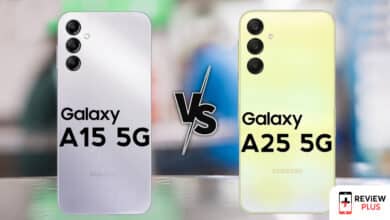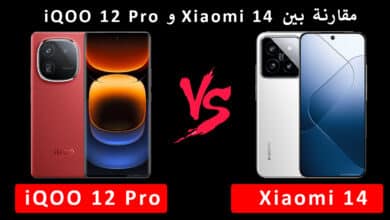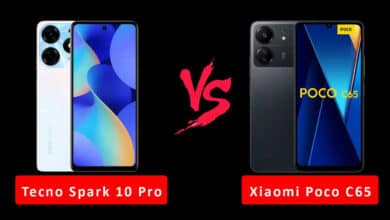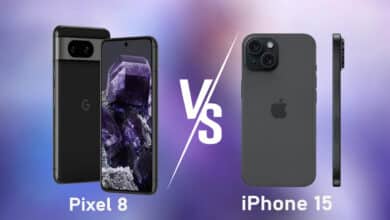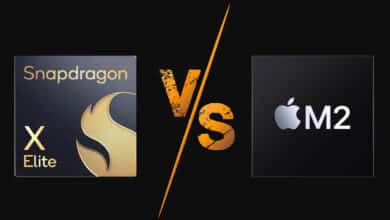We show you a detailed comparison between Samsung S23 And Zenfone 10 and clarify the most prominent differences, advantages and disadvantages of both phones through this comprehensive comparison between the two phones.
Since both Asus Zenfone 10 and Samsung Galaxy S23 are small sized phones, some users may face difficulties in making the appropriate decision. Therefore, we decided to extend a helping hand to those and review a detailed comparison between both phones.
Comparison between Samsung Galaxy S23 and ASUS Zenfon 10
ASUS Zenfone 10 It is the latest Asus flagship phone in the market, which was launched a few days ago. This phone is called the “compact” or “sealed” phone due to its small size.
It's a great choice for those with smaller hands who struggle with large screens or who want to find a pocketable phone.
But just like the base Samsung Galaxy S23 model. The size difference between the two screens is only 1.1 inches, which means that they are both approximately the same size.
The Galaxy S23 also weighs, according to the specifications sheet, 168 grams, while the Zenfone 10 phone, according to technical specifications, weighs 172 grams, meaning there is not even a noticeable difference in the weight of the two phones.
Although both phones come in almost uniform sizes, there are many notable differences between both that will help us determine the best between them, whether it is in terms of camera performance, design, building materials and quality, or even the usual software for both.
Fortunately, there are many reviews of both phones spread on the Internet, which helped us greatly in making this comparison.
Let's get to know the most important differences between the Samsung Galaxy S23 and ASUS Zenfone 10.
ASUS Zenfone 10 camera is supported by 6-axis stabilization technology

You must be sure that both phones will provide you with an amazing photography experience in all circumstances. Samsung's flagship Galaxy S series has always been known for its photographic capabilities and its quality in image clarity, detail and color accuracy. But the Zenfone 10 is not much different either.
However, there is an amazing feature in the ZenFone 10 main camera, which is the 6-axis stabilization technology, which is an advanced technology that is “theoretically” better than the traditional OIS technology on the Galaxy S23.
Of course, OIS optical stabilization technology depends on giving the camera sensor freedom of movement by 0.5 degrees in all directions, which helps to provide detailed and more stable images to resist lateral vibration during shooting.
Six-axis Gimbal Stabilization gives the main camera sensor on the Asus Zenfone 10 full freedom of movement to ensure more stable images and better resistance to shake than standard OIS-based sensors.
According to the ASUS Zenfone 10 spec sheet, the 6-axis stabilization technology should ensure the ability to move the entire camera module is 3 times better than the camera module on the Galaxy S23. This means that the sensor has a range of motion of 1.5 degrees instead of just 0.5 degrees in all directions. .
This feature may not be important if you are using a stand while shooting. But if the issue of photography for you is usually surprising and you find yourself in the need to record videos and are afraid of the constant vibrations of your hand while filming, the Asus Zenfone 10 should give you better stability.
More importantly, and surprisingly, the ASUS Zenfone 10 reviews prove just how ingenious the phone's 6-axis stabilization technology is. In a nutshell, it's not just a feature on paper, it's a really practical and useful feature, and you'll find the 6-axis stabilization activation icon on your screen while shooting to check if it's activated.
Through camera tests, it became clear that the sensor is also sometimes unable to clarify details in some images as a result of continuous vibrations, which may cause blurring and distortion of fine details.
However, the idea of the 6-axis stabilization technology is to give the user the ability to shoot and record video with one hand without having to use a tripod. There are also many advanced shooting modes that Zenfone 10 supports, including night mode, light effect, and more, without the need to use a stand.
But does this mean that the imaging results will be distorted on the Galaxy S23? of course no. In fact, the truth is quite the opposite.
We've confirmed through reviews that the standard OIS technology does a great job of giving the sensor the ability to live with lateral vibrations during normal shooting. ASUS Zenfone 10 may still be the best in stability yes, but the Galaxy S23 won't let you down either.
Just remember that the Samsung Galaxy S23 supports 4K video shooting at 30/60fps, while the maximum video resolution on the ASUS Zenfone 10 is 1080p.
The Galaxy S23 also has a 3x optical zoom Telephoto sensor and a 12MP ultra-wide lens. Therefore, if the issue of bringing distant objects closer while shooting is one of your most important requirements, then you should consider a Samsung phone.
Galaxy S23 design is the best in terms of texture and build quality

ASUS Zenfone 10 has a back made of polycarbonate, a high-quality recycled plastic. However, it does not match the glass back of the Samsung Galaxy S23, which gives the phone an elegant look and a high-end feel that makes it a truly flagship phone, just like its more expensive brother, the Ultra.
Through the reviews of the ASUS Zenfone 10, it seems that the reviewers were not completely happy with the design of the phone and the back cover, which gives them a texture that seems uncomfortable in the hand. This is a real problem considering a flagship phone whose price exceeds $ 700 USD.
This does not mean that the design of Zenfone 10 is bad, at least the materials from which the phone is made play a major role in preserving the environment and reducing the petrochemical materials used in manufacturing processes.
But the whole point is that the consumer doesn't want to spend a large amount of money on a phone that might feel uncomfortable while holding it in the palm of their hand.
Also, you may notice that the Galaxy S23 is protected with Victus 2 from Corning, which is the latest anti-fingerprint and anti-bacterial layer. As for the Zenfone 10, it has a screen protected by the first generation Victus layer.
To be honest with you, there are no notable differences between the two types of protection layers, but despite this, these differences still mean that Samsung has invested more resources and spent more money on the Galaxy S23.
But if you're an Asus fan, you can still enjoy an impressive array of eye-catching red, green, Black, blue and white color options.
The Zen UI on the Zenfone 10 is highly customizable

Both phones run Android 13, but they each have a different operating interface. The software from Asus is based on the Zen UI interface, while the software from Samsung is based on the One UI interface.
Samsung's One UI has a plethora of great features that can be hard to find on any other phone. And Samsung was able to modify a large number of user interface elements in order to attract the attention of users.
Everything looks great on One UI 5.1 on the Galaxy S23 – from the redesigned app widgets and icons to the flexible and easy-to-access settings panel to easy handling of incoming notifications and more.
As for ASUS, it has tried to make its software similar to stock Android.
This does not mean that the Zen UI interface is 100% similar to the stock Android system, but you will notice that the user interface is very similar to the original Android system.
Samsung provides long-term software support

Although the Zen UI interface may easily win your admiration due to its great similarity to the stock Android system, but it is difficult for any company to beat Samsung when it comes to official long-term support.
For example, Asus promised to support the Asus Zenfone 10 for two years, which means that the phone will be eligible for Android 15 in the future.
But in contrast, the Galaxy S23 is supported by four years of official support, meaning that it will get Android 17 in due time, and the support period with the necessary patches to fix security vulnerabilities may reach five years.
There is no doubt that the best support is in favor of the Galaxy S23 and it will be an ideal deal for those people who do not prefer to replace their phones every year or two.
This means that you will get all the new features of future Android systems, and you will enjoy better protection and security for many more years.
The price is in favor of the ASUS Zenfone 10
Well, both phones come at very close prices. However, the ASUS Zenfone 10 is still cheaper by a few thousand Egyptian pounds.
But all in all, the price differences are negligible if your budget is generally in the $850 range.
Comparison summary between Samsung Galaxy S23 and Asus Zenfon 10
There is bound to be one winner in any comparison of two phones. But choosing the winner in this competition depends on your requirements and needs from the phone. While ASUS Zenfone 10 guarantees you better optical stabilization, Galaxy S23 gives you greater approximation.
The build quality and design may be in favor of the Galaxy S23, but the Zenfone 10 is still the cheapest.
Battery life will be better on the Zenfone 10 because it has a 400mAh larger battery that may guarantee you the ability to use the phone for several more hours.
The software on both phones is great, but while Asus tries to stick as closely as possible to the original Android interface, Samsung will give you extended support for several years longer. We hope we were able to cover the most important differences between both phones.
Both are more than great phones and will provide you with exemplary performance in all tasks thanks to the leading processor.
But there are tangible differences in camera setup, build quality, and software. And you should be able to decide which phone is better by the differences we touched on in this comparison.

